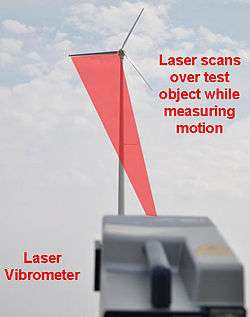Continuous scan laser Doppler vibrometry

Continuous scan laser Doppler vibrometry (CSLDV) is a method of using a laser Doppler vibrometer (LDV) in which the laser beam is swept across the surface of a test subject to capture the motion of a surface at many points simultaneously. This is different from scanning laser vibrometry (SLDV) in which the laser beam is kept at a fixed point during each measurement and quickly moved to a new position before acquiring the next measurement.
Advantages and disadvantages
CSLDV can allow one to capture the mode shapes of a structure with high resolution much more quickly than would be possible with SLDV. Allen & Sracic [1] show results where measurements were acquired with CSLDV in a hundredth of the time that would be required for LDV. Allen & Aguilar [2] postulated that the additional detail available from CSLDV might provide important information when validating structural dynamic models. CSLDV also makes testing with an instrumented hammer practical with LDV, and some have speculated that CSLDV might be useful in cases where it is impossible to recreate the input forces, such as explosive loadings.
The primary disadvantage of CSLDV is the additional laser speckle noise that occurs if the laser spot scans the structure too quickly. Speckle noise is caused by micro-scale irregularities in the surface that change the intensity pattern of the laser light received by the LDV as it scans the surface. Similar problems arise when applying LDV to rotating shafts, crankshafts for example. Speckle noise is difficult to predict, depending on the properties of the surface, the geometry of the structure and position of the LDV,[3] so further research is needed to establish the limits of CSLDV.
History
Sriram et al.[4] seem to have been the first to publish regarding CSLDV, although they studied it for only a few years and discontinued research. Most of the subsequent advances in this area have arisen from the group at Imperial College in London by Stanbridge, Ewins, Martarelli and Di Maio,[5][6][7][8] who coined the term "CSLDV".
Allen's research group at the University of Wisconsin-Madison began work in this area in 2006 and published the first output-only CSLDV algorithm [9] and extended the Harmonic Transfer Function methodology by Wereley & Hall to CSLDV measurements.[10]
Application
Zhu's research group at the University of Maryland, Baltimore County applied CSLDV to structural damage detection and developed a damage identification methodology for beams that uses demodulation and polynomial methods.[11]
External links
The video in the link below illustrates the process and some of the scan patterns that are possible.
References
- ↑ Allen, M. S.; Sracic, M. W. (2010). "A New Method for Processing Impact Excited Continuous-Scan Laser Doppler Vibrometer Measurements". Mechanical Systems and Signal Processing. 24: 721–735. doi:10.1016/j.ymssp.2009.11.004.
- ↑ M. S. Allen and D. M. Aguilar, "Model Validation of a Bolted Beam Using Spatially Detailed Mode Shapes Measured by Continuous-Scan Laser Doppler Vibrometry," in 50th AIAA/ASME/ASCE/AHS/ASC Structures, Structural Dynamics, and Materials Conference Palm Springs, California, 2009.
- ↑ Rothberg, S. (2006). "Numerical simulation of speckle noise in laser vibrometry". Applied Optics. 45: 4523–33. doi:10.1364/ao.45.004523.
- ↑ Sriram, P.; Craig, J. I.; Hanagud, S. (1990). "Scanning laser Doppler vibrometer for modal testing". International Journal of Analytical and Experimental Modal Analysis. 5: 155–167.
- ↑ Stanbridge, A. B.; Ewins, D. J. (1999). "Modal testing using a scanning laser Doppler vibrometer". Mechanical Systems and Signal Processing. 13: 255–70. doi:10.1006/mssp.1998.1209.
- ↑ R. Ribichini, D. Di Maio, A. B. Stanbridge, and D. J. Ewins, "Impact Testing With a Continuously-Scanning LDV," in 26th International Modal Analysis Conference (IMAC XXVI) Orlando, Florida, 2008.
- ↑ M. Martarelli, "Exploiting the Laser Scanning Facility for Vibration Measurements," in Imperial College of Science, Technology & Medicine. vol. Ph.D. London: Imperial College, 2001.
- ↑ Martarelli, M.; Ewins, D. J. (2006). "Continuous scanning laser Doppler vibrometry and speckle noise occurrence". Mechanical Systems and Signal Processing. 20: 2277–89. doi:10.1016/j.ymssp.2005.06.003.
- ↑ Yang, S.; Allen, M. S. (2012). "Output-Only Modal Analysis Using Continuous-Scan Laser Doppler Vibrometry and Application to a 20kW Wind Turbine". Mechanical Systems and Signal Processing. 31: 228–245. doi:10.1016/j.ymssp.2012.04.012.
- ↑ Yang, S.; Allen, M. S. (2014). "Harmonic Transfer Function to Measure Translational and Rotational Velocities with Continuous-scan Laser Doppler Vibrometry". ASME Journal of Vibrations and Acoustics. 136.
- ↑ Chen, Da-Ming; Xu, Y. F.; Zhu, W. D. (2016). "Damage Identification of Beams Using a Continuously Scanning Laser Doppler Vibrometer System". ASME Journal of Vibration and Acoustics. 138 (5): 051011. doi:10.1115/1.4033639.